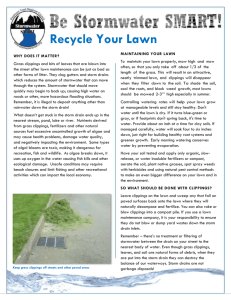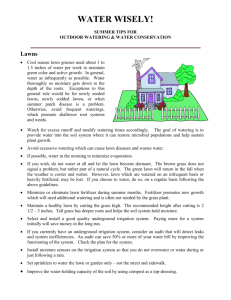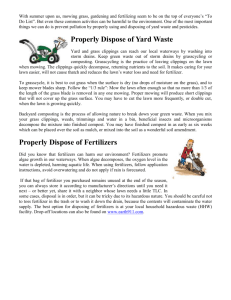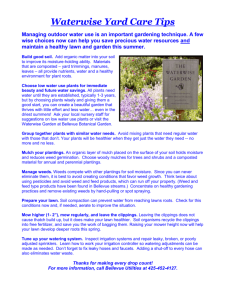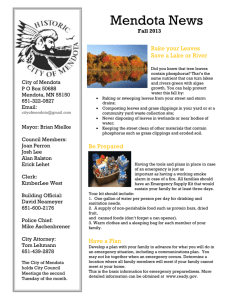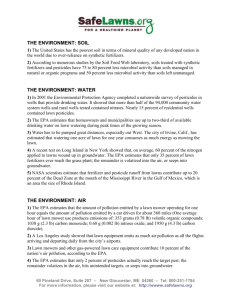Lawn Care Guide 2
advertisement
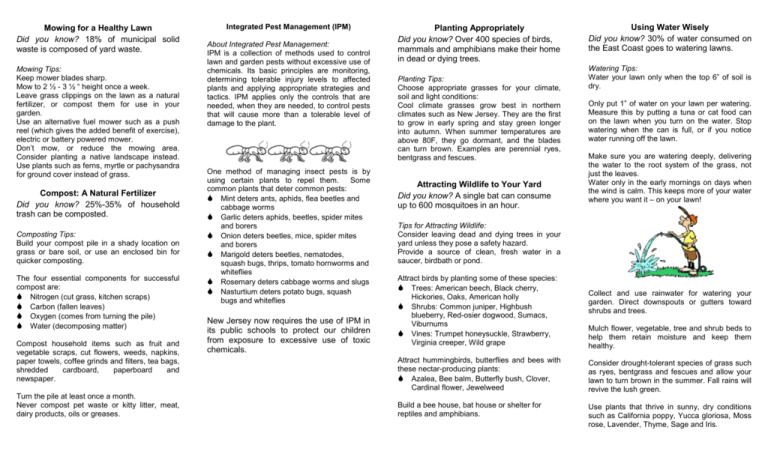
Mowing for a Healthy Lawn Did you know? 18% of municipal solid waste is composed of yard waste. Mowing Tips: Keep mower blades sharp. Mow to 2 ½ - 3 ½ “ height once a week. Leave grass clippings on the lawn as a natural fertilizer, or compost them for use in your garden. Use an alternative fuel mower such as a push reel (which gives the added benefit of exercise), electric or battery powered mower. Don’t mow, or reduce the mowing area. Consider planting a native landscape instead. Use plants such as ferns, myrtle or pachysandra for ground cover instead of grass. Compost: A Natural Fertilizer Did you know? 25%-35% of household trash can be composted. Composting Tips: Build your compost pile in a shady location on grass or bare soil, or use an enclosed bin for quicker composting. The four essential components for successful compost are: Nitrogen (cut grass, kitchen scraps) Carbon (fallen leaves) Oxygen (comes from turning the pile) Water (decomposing matter) Compost household items such as fruit and vegetable scraps, cut flowers, weeds, napkins, paper towels, coffee grinds and filters, tea bags, shredded cardboard, paperboard and newspaper. Turn the pile at least once a month. Never compost pet waste or kitty litter, meat, dairy products, oils or greases. Integrated Pest Management (IPM) About Integrated Pest Management: IPM is a collection of methods used to control lawn and garden pests without excessive use of chemicals. Its basic principles are monitoring, determining tolerable injury levels to affected plants and applying appropriate strategies and tactics. IPM applies only the controls that are needed, when they are needed, to control pests that will cause more than a tolerable level of damage to the plant. One method of managing insect pests is by using certain plants to repel them. Some common plants that deter common pests: Mint deters ants, aphids, flea beetles and cabbage worms Garlic deters aphids, beetles, spider mites and borers Onion deters beetles, mice, spider mites and borers Marigold deters beetles, nematodes, squash bugs, thrips, tomato hornworms and whiteflies Rosemary deters cabbage worms and slugs Nasturtium deters potato bugs, squash bugs and whiteflies New Jersey now requires the use of IPM in its public schools to protect our children from exposure to excessive use of toxic chemicals. Planting Appropriately Did you know? Over 400 species of birds, mammals and amphibians make their home in dead or dying trees. Planting Tips: Choose appropriate grasses for your climate, soil and light conditions: Cool climate grasses grow best in northern climates such as New Jersey. They are the first to grow in early spring and stay green longer into autumn. When summer temperatures are above 80F, they go dormant, and the blades can turn brown. Examples are perennial ryes, bentgrass and fescues. Attracting Wildlife to Your Yard Did you know? A single bat can consume up to 600 mosquitoes in an hour. Using Water Wisely Did you know? 30% of water consumed on the East Coast goes to watering lawns. Watering Tips: Water your lawn only when the top 6” of soil is dry. Only put 1” of water on your lawn per watering. Measure this by putting a tuna or cat food can on the lawn when you turn on the water. Stop watering when the can is full, or if you notice water running off the lawn. Make sure you are watering deeply, delivering the water to the root system of the grass, not just the leaves. Water only in the early mornings on days when the wind is calm. This keeps more of your water where you want it – on your lawn! Tips for Attracting Wildlife: Consider leaving dead and dying trees in your yard unless they pose a safety hazard. Provide a source of clean, fresh water in a saucer, birdbath or pond. Attract birds by planting some of these species: Trees: American beech, Black cherry, Hickories, Oaks, American holly Shrubs: Common juniper, Highbush blueberry, Red-osier dogwood, Sumacs, Viburnums Vines: Trumpet honeysuckle, Strawberry, Virginia creeper, Wild grape Collect and use rainwater for watering your garden. Direct downspouts or gutters toward shrubs and trees. Mulch flower, vegetable, tree and shrub beds to help them retain moisture and keep them healthy. Attract hummingbirds, butterflies and bees with these nectar-producing plants: Azalea, Bee balm, Butterfly bush, Clover, Cardinal flower, Jewelweed Consider drought-tolerant species of grass such as ryes, bentgrass and fescues and allow your lawn to turn brown in the summer. Fall rains will revive the lush green. Build a bee house, bat house or shelter for reptiles and amphibians. Use plants that thrive in sunny, dry conditions such as California poppy, Yucca gloriosa, Moss rose, Lavender, Thyme, Sage and Iris. Careful Use of Chemicals Did you know? The average suburban lawn receives 10 times as much chemical pesticide per acre as farmland. Tips for Using Pesticides: Pesticides include grub control, weed killer, fungus treatment, insect spray, crab grass preventer, insecticides and herbicides. Remember that pesticides are poisons, and may be carried into your home by shoes, paws and air currents. Due to their size and behaviors, children and pets are particularly vulnerable to the toxic effects of pesticides. When cleaning out pesticide and fertilizer applicators, rinse them out over your lawn, not on the sidewalk or driveway where the residue will flow directly into the nearest stream. Lawn weed seedlings may be killed by an application of corn gluten, a natural pesticide available from garden suppliers. Apply annually before the weeds emerge for best results. Tips for Fertilizing: Test your soil yearly for nutrients and acidity. Optimal pH is about 7. If the soil is too acidic (pH below 7), add lime. If the soil is too alkaline (pH above 7), add sulfur. Use fertilizers to supplement only the nutrients that are deficient in your soil: N=Nitrogen, P=Phosphorus, K=Potassium Resources Informative Websites: New Jersey Environmental Center: www.njenvironment.org Rutgers Cooperative Extension: www.rce.rutgers.edu NRCS Tips for Home & Garden care: www.nrcs.usda.gov/feature/highlights/homegard en/lawn.html NRCS Backyard Fact Sheets: www.nrcs.usda.gov/feature/backyard Pesticide Action Network: www.panna.org Beyond Pesticides: www.beyondpesticides.org Books: Common Sense Pest Control by W. Olkowski, S. Daar and H. Olkowski, 1991 Handbook of Successful Ecological Lawn Care by Paul Sachs, 1996 Tiny Game Hunting by Hilary Klein and Adrian Wenner, 2001 Redesigning the American Lawn by F. Bormann, D. Balmori and G. Geballe, 2001 Products: Lawn-A-Live, Ridgewood, NJ: 1-800-443-5296 Organic Gardening supplies: www.gardensalive.com Gardener’s Supply Company: www.gardeners.com Indoor/Outdoor earth friendly gardening supplies: www.wormsway.com Yearly Schedule for Lawn Care March & April Sharpen mower blades, raise to 3” Test your soil Add soil amendments (lime, sulfur or fertilizer) based on soil test results Re-seed bare patches or apply corn gluten to prevent weed germination Leave clippings on lawn to fertilize Aerate soil if it is compacted add to compost pile Re-seed bare spots Monitor for insect pests If you have grub damage, spot treat with milky spore (once per 10 years) and/or with beneficial nematodes (once yearly for 2-3 years) Add lawn clippings to compost pile July & August Allow the lawn to go dormant during drought. It will green up again after rain. Add lawn clippings to compost pile Seed generously (if necessary) Fertilize (if necessary) or top dress with ¼ “ of compost Apply fertilizer when the soil is moist, then water lightly. Do not apply when rain or wind is expected. November This guide was created by the Association of New Jersey Environmental Commissions. For more information, visit www.anjec.org or call 973-539-7547. An Environmentally Friendly Lawn Care Guide May & June Check for weeds; pull out by hand and September & October Fertilize once in late spring and once in autumn, no more is necessary. Protection for Streams and Reservoirs Begins in Your Backyard Final mowing at 2” for easier leaf raking Add fallen leaves and lawn clippings to compost pile Clean water sustains life for all of us. Protection of our water depends on our actions and choices. A great place to begin protecting drinking water is in your own yard. The rainwater that falls on our lawns and gardens picks up some of the pesticides and fertilizers that we use to beautify our properties. This water flows directly to the nearest stream, and often into our drinking water supply. A healthy lawn is aesthetically pleasing and environmentally beneficial because it can help prevent erosion, and acts as a filter for stormwater from downspouts, driveways, parking areas and roadways. Here are some tips to help you maintain a healthy lawn by using environmentally friendly methods to ensure that we can all enjoy clean water for years to come. Courtesy of (insert your town’s name) Environmental Commission 2004

